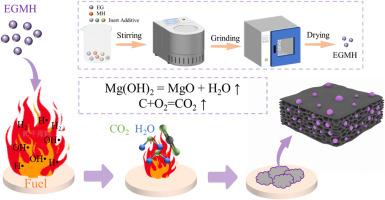用于正庚烷池火灾的氢氧化镁增强可膨胀石墨灭火剂的研制与评价
IF 4.2
3区 工程技术
Q2 ENGINEERING, CHEMICAL
Journal of Loss Prevention in The Process Industries
Pub Date : 2025-09-12
DOI:10.1016/j.jlp.2025.105794
引用次数: 0
摘要
采用机械球磨法制备了一种新型干粉灭火剂——氢氧化镁改性膨胀石墨。改变后的材料具有层状微观结构,颗粒尺寸明显减小,热稳定性提高。利用扫描电子显微镜、x射线衍射、傅里叶变换红外光谱和热重分析对石墨基体进行了结构表征,验证了氢氧化镁在石墨基体内的成功表面加载和部分嵌入。在正庚烷池火试验中,EGMH表现出优异的灭火效果,在14秒内以仅55克的消耗和15.05℃/s的冷却速度扑灭火焰。与商用ABC干粉和未改性的可膨胀石墨(EG)相比,EGMH具有更好的抑焰和保温效果。性能的提高是由于EG膨胀、水蒸气释放和分解过程中形成致密的MgO层的协同作用。这些研究结果表明,EGMH是一种高效、经济、环保的碳氢化合物火灾灭火方法。本文章由计算机程序翻译,如有差异,请以英文原文为准。

Development and assessment of a magnesium hydroxide-enhanced expandable graphite fire suppressant for n-heptane pool fires
A novel dry powder fire extinguishing agent, expandable graphite modified with magnesium hydroxide (EGMH), was synthesised via mechanical ball milling. The altered material had a stratified microstructure with markedly decreased particle size and improved thermal stability. The structural characterisation using scanning electron microscopy, X-ray diffraction, Fourier transform infrared spectroscopy, and thermogravimetric analysis validated the successful surface loading and partial intercalation of magnesium hydroxide inside the graphite matrix. In n-heptane pool fire tests, EGMH demonstrated exceptional suppression efficacy, extinguishing flames in 14 s with a consumption of merely 55 g and a cooling rate of 15.05 °C/s. In comparison to commercial ABC dry powder and unmodified expandable graphite (EG), EGMH exhibited superior flame suppression and thermal insulation efficiency. The improved performance is due to the synergistic effects of EG expansion, water vapour release, and the creation of a dense MgO layer during decomposition. These findings indicate the efficacy of EGMH as a highly effective, cost-efficient, and eco-friendly fire suppression for hydrocarbon fires.
求助全文
通过发布文献求助,成功后即可免费获取论文全文。
去求助
来源期刊
CiteScore
7.20
自引率
14.30%
发文量
226
审稿时长
52 days
期刊介绍:
The broad scope of the journal is process safety. Process safety is defined as the prevention and mitigation of process-related injuries and damage arising from process incidents involving fire, explosion and toxic release. Such undesired events occur in the process industries during the use, storage, manufacture, handling, and transportation of highly hazardous chemicals.

 求助内容:
求助内容: 应助结果提醒方式:
应助结果提醒方式:


